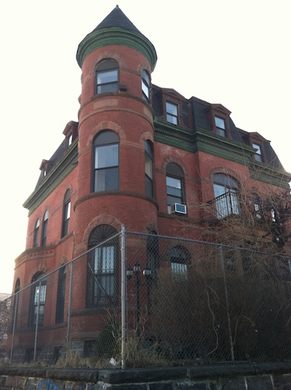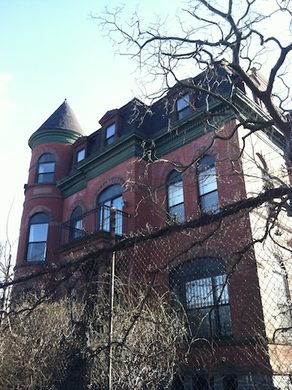Lipsius Cook House
This 19th century brick building in Brooklyn stands out like the anachronistic landmark that it is.
On Bushwick Avenue just blocks away from the Myrtle/Broadway JMZ line, a tower rises from the horizon whose source can be found at the corner of Bushwick Avenue and Willoughby.
Declared a Landmark Site in 2013, the Lipsius-Cook House has survived while all of the surrounding historic buildings were destroyed, lots developed over into modern structures. As the last of its kind, it can’t help but be noticed. Long periods of ownership have helped to keep this building intact in much of its original condition, and its fascinating history has kept it interesting, as scandal and intrigue mark the house and its interesting former inhabitants.
Originally the building was commissioned in 1889 by Catharina Lipsius, the widow of Henry Claus, one of Brooklyn’s earliest beer brewers since 1865. The architect, Theobald Engelhart, was one of the most revered architects in the German community, who also designed the Eberhard Faber Pencil Company and the William Ulmer Brewery. He designed the Lipsius house in the Rundbogenstil style, its distinct execution earning the title “American Round-Arch”.
The plot was on undeveloped land in Brooklyn’s primarily German district of Bushwick. German immigrants, fleeing turmoil in Europe after several unsuccessful revolutions in 1848, brought with them a love for Lager beers and the methods for its production. The brewery itself was located at 471 Bushwick Avenue, along with many other breweries, earning Bushwick Avenue the moniker “Brewer’s Row”. The widow Catherina later married Rudolf Lipsius who continued the business, renaming the brewing company Claus Lipsius Brewery. But by the time the house at 670 Bushwick Avenue was built, he had passed on, leaving Catherina a twice-widow. The family remained in the house until 1902, and her son continued in the beer business until its closure in 1906.
The next owner of the house was Dr. Frederick A. Cook, also of German heritage, and his wife. As a successful physician working from the house, he became ship doctor aboard Robert E. Peary’s many arctic exploration journeys in the 1890s. His anthropological discoveries and photographs during these expeditions are highly regarded. Cook was the first man to reach the peak of Mount McKinley in 1906, but later gained notoriety over the scandal that erupted over his claim that he was the first to arrive at the North Pole in 1908. Peary declared Cook’s claim impossible and his own claim in 1909 the legitimate one. He continued to undermine Cook’s achievements through his relationships with the National Geographic Society and other established exploration organizations where he had a longstanding reputation. Cook’s battles to support his first at the North Pole led to his ruin and the foreclosure of the house in 1920.
670-674 Bushwick Avenue returned to the Lipsius family in 1920 after Cook lost ownership. Its next owners were an Italian family, marking the decline of the neighborhoods German majority. In 1960, the house was sold again to a doctor, Clement Davis, and his wife Eleanor, who owned it until 1995. Its current owners bought the building in 2000, and it has since been listed a multiple resident private property since.
Community Contributors
Added by
Edited by
The Atlas Obscura Podcast is Back!























Follow us on Twitter to get the latest on the world's hidden wonders.
Like us on Facebook to get the latest on the world's hidden wonders.
Follow us on Twitter Like us on Facebook